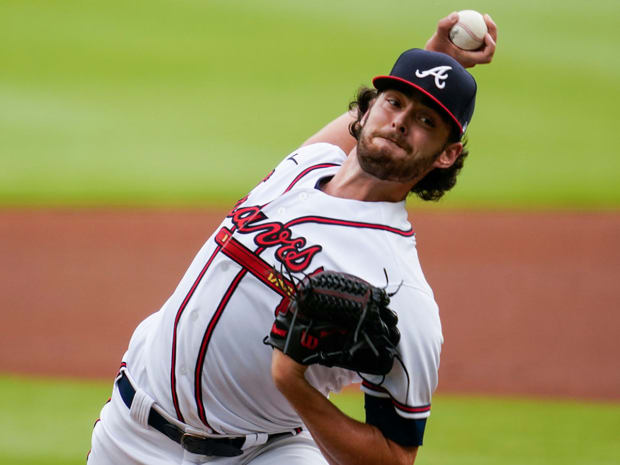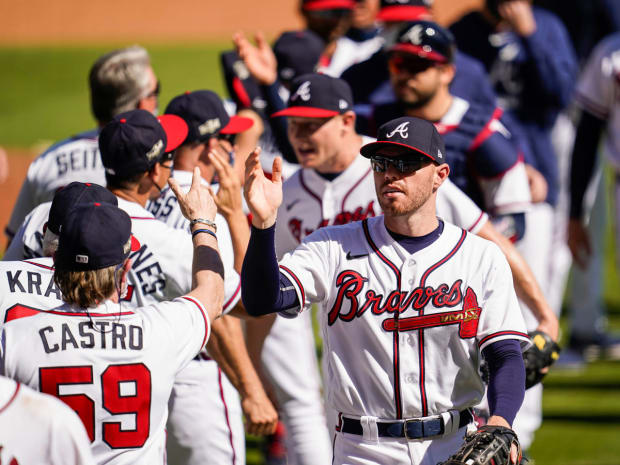The Braves are youthful, dynamic and have the arms to play deep into October. It all starts with 22-year-old rookie Ian Anderson, who pairs perfectly with ace Max Fried.
This would be a good time to start taking seriously the Atlanta Braves, the team MLB designated as the matinee team the past two days (noon starts) that had lost 10 consecutive postseason series since 2001. In two days, even against one of the worst-hitting clubs of all time, the Braves redefined themselves as much more than a team that can mash.
Thanks to homegrown starting pitchers Max Fried and Ian Anderson turning into the modern day Mathewson and McGinnity, and a deep bullpen behind them, Atlanta served notice it has the arms to do more than just get out of the first round for the first time since the roster included Julio Franco, who was born when Tris Speaker (born 1888) was still alive.
“I remember Bobby [Cox] told me one time, ‘You need to grow your own,’” Braves manager Brian Snitker said.
Anderson, 22, is the difference-maker, capable of reshaping what you thought you knew about this postseason the way rookie Michael Wacha of the Cardinals did in 2013. Anderson is so young he was three years old the last time the Braves won a postseason series. He is so young one of his early baseball memories is watching his dad in their suburban Albany, N.Y., home get excited about their favorite team, the Red Sox, winning the 2004 World Series. He is younger than Google.
But Wednesday at Truist Park in Atlanta this is what mattered most about his youthfulness: he became the third youngest starting pitcher to throw shutout ball in a clinching win. Only Bret Saberhagen, 21, in the 1985 World Series, and Wacha, 22, in the 2013 National League Championship Series, did so at a younger age.
Wacha was 43 days younger than Anderson. Wacha had thrown 64 2/3 innings entering that postseason before emerging on the national radar to help carry St. Louis to the World Series. Anderson had thrown half as many innings, starting just six games prior to Thursday's. Anderson has a similarly impressive fastball-changeup combination, but he has a better curveball, better command and a less stressful delivery.
Despite his youth, Anderson has an old soul way about him on the mound. He is as calm as the deepest lake on a windless day. “I always try not to show the other team anything when I’m out there,” he said.
Even more impressive is how he commands all three pitches, all of which are plus pitches.
“He’s got great stuff and he’s also got the command to go with it,” Braves outfielder Adam Duvall said. “He can throw three pitches for a strike. He doesn’t have to throw the fastball to get ahead.”
No better example of Anderson’s combination of stuff and guile existed than an at-bat against Reds catcher Tucker Barnhart in the second inning, when the game hung precariously in the balance. Anderson had just walked Freddy Galvis to load the bases with two outs. He had gone away from his changeup in the inning. Pitching coach Rick Kranitz visited the mound.
“Stick with your strength,” Kranitz told him.

Anderson did not adopt a changeup until 2018 in High A. He quickly gained a feel for the pitch. By last season it had become what he called “my go-to pitch.” He throws the changeup between 87-90 mph, with uncannily similar arm speed and release as his fastball. Only great changeups can be thrown in the strike zone and still fool hitters. Anderson throws a great changeup.
Properly reminded, Anderson returned to his strength. He threw Barnhart three consecutive changeups. The results: swing and miss, swing and miss, groundout to end the inning. He cruised from there.
Anderson threw six innings before Snitker saw a pocket of lefties coming up in the seventh in a 1-0 game and turned the game over to Will Smith. The bullpen neatly closed out the 5-0 win. That is the leverage-aware kind of managing you must do in the postseason, which Cubs rookie manager David Ross missed Tuesday against Miami. In part because Ross felt hamstrung by the awful three-batter minimum rule–the first all-out assault on strategy in the game’s history–Ross let starter Kyle Hendricks face a lefty late in the game with more than 100 pitches. Corey Dickerson burned him with a three-run homer. It was the first time in 294 consecutive postseason starts that a manager lost a game with his starting pitcher in the seventh inning or later–since the Cubs beat Johnny Cueto in the 2016 NLDS.
Snitker has the kind of deep bullpen with nasty stuff to be the proactive manager today’s playoff baseball demands. You simply cannot lose games with tiring starting pitchers.
Thanks to deep staffs, the overall postseason batting average after Atlanta’s win Wednesday dropped to .217. Thirty-nine percent of all outs were strikeouts.
A team like the Reds just did not have enough quality at-bats to survive the pitching the Braves threw at them. Cincinnati went home from the playoffs without scoring a run in 22 innings, a postseason record.
All the talk about the Reds being a “dangerous” draw because of their starting pitching was overstated. Cincinnati just didn’t hit well enough. The Reds batted .212, the second-lowest average of all time, behind only the 1906 deadball White Sox, who hit .210, went 68-85 and featured Lena Blackburne, the .174-hitting shortstop who became famous around the game by fashioning the mud mixture used to rub up MLB baseballs. The Reds hit .199 against winning teams. One-ninety-nine.
Four years ago, the Reds and Braves were in another kind of competition. The Reds held the No. 2 pick in the 2016 draft. Right behind them were the Braves, who were in the middle of a three-year run in which they lost 90 games or more. The Phillies, at No. 1, took high school outfielder Mickey Moniak. Cincinnati took Nick Senzel, a college position player.
Not many experts rated Anderson among the top five talents in the draft. He didn’t throw nearly as hard as high school pitchers such as Riley Pint. Anderson, at 6-foot-3, weighed only 170 pounds. He endured an oblique strain and pneumonia in his senior season at Shenendehowa High in the cold spring typical along the Mohawk River in upstate New York. His fastball sat around 90-91. On a good day he touched 93. He did show an outstanding curveball.

The Braves saw something else that didn’t turn up in the radar gun readings or the spin rate metrics. They saw poise, maturity, and a polished delivery. They were on him since the previous summer, when he pitched for Team USA. They kept talking about how he reminded them of Mike Mussina. They rated him as the top pitcher available. Taking him at No. 3, and keeping him away from his Vanderbilt commitment, they signed him for $4 million–$1.5 million below slot.
Anderson has filled out and gained velocity the way smart scouts prefer: he grew into it, rather than throwing in the high 90s before the body fully matures, stressing tendons. On Wednesday he hit 96.8 mph, the fastest pitch he has thrown in his young career. There is more in that tank.
“I’m coming to expect it,” Snitker said after watching a 21-year-old rookie with six career starts throw shutout ball in a postseason clincher and do it with the calm of a jewel cutter. “I guess that’s great.”
Occasionally Snitker would take a peek down the bench between innings to see how the kid was holding up in what was another squeaky-tight game with no margin for error. He saw the usual signals from Anderson: nothing.
“I looked at him sitting there and he doesn’t look his age,” Snitker said, “like he’s out there on the sandlot playing ball.”
The next time Anderson takes the ball it will be in Houston on Wednesday against either the Cubs or Marlins in Game 2 of the NLDS. He will follow Fried again. Fried is 26, the seventh overall pick in 2012, also drafted out of high school, when he weighed 165 pounds and threw 92 mph on his good days. Homegrown, the two of them shut out the Reds over 13 playoff innings. Like McGinnity following Mathewson, they are brothers in arms–and zeroes.
October 02, 2020 at 04:34AM
Rookie Ian Anderson Makes Braves Dangerous in October

No comments:
Post a Comment
Thank You for sharing your views. I hope you like the arts posted.